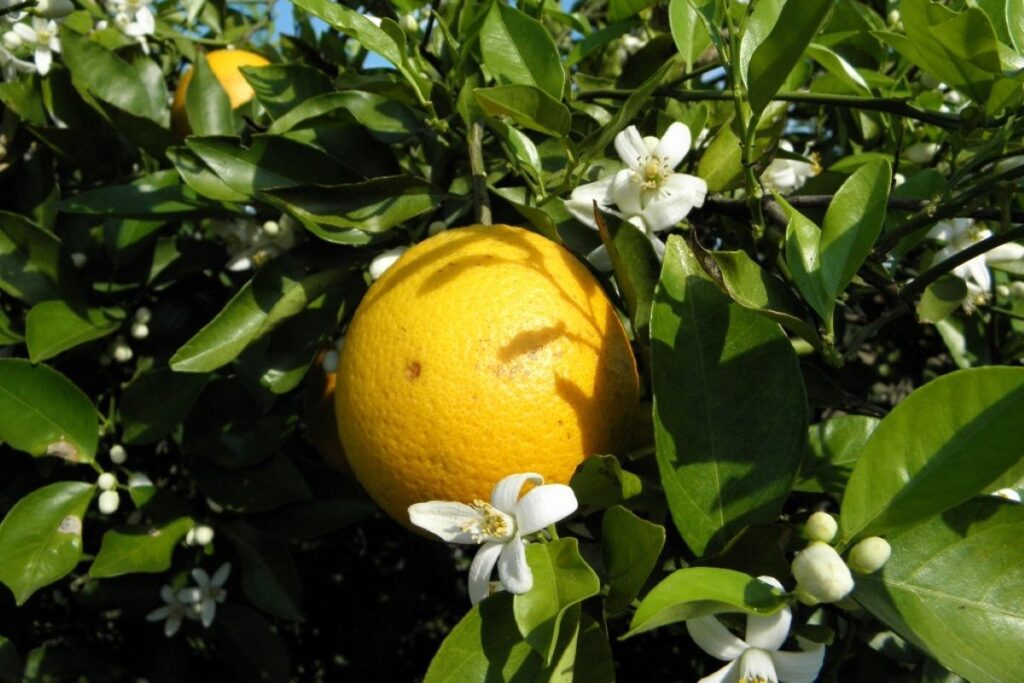- About Us
- Our Work
- Tree Info
- Get Involved
- Blog
- Volunteer
- Support Us

Potted fruit trees are a great way to introduce the benefits of trees to your home if you have limited space. If you have a potted citrus, fig, or avocado tree, follow these guidelines for healthy growth and bountiful harvests.
View our “Caring for Potted Fruit Trees” brochure
Los árboles frutales en maceta son una forma excelente de introducir los beneficios de los árboles en tu hogar si tienes poco espacio. Si tienes un cítrico, una higuera o un aguacate en maceta, sigue estas pautas para un crecimiento sano y cosechas abundantes.
Vea nuestro folleto “Guía para el cuidado de árboles frutales en maceta”
Place the tree in a spot outside that receives full or direct sunlight for 6-8 hours a day. Your fruit tree needs lots of sunlight to produce delicious fruit!
Coloque el árbol en un lugar exterior que reciba luz solar directa o total durante 6 a 8 horas al día. ¡Su árbol frutal necesita mucha luz solar para producir fruta deliciosa!
Feel the top couple inches of soil with your finger. If it’s dry, it’s time to water! Avoid overwatering and allowing the tree to stand in water for prolonged periods. The frequency of watering depends on the size of the container, the soil, the temperature, and how much wind the tree is exposed to. Larger containers retain water better, so they need to be watered less often. In the summer, be prepared to water multiple times each week.
Con el dedo, tantee los dos centímetros superiores de la tierra. Si está seca, ¡es hora de regar! Evite regar en exceso y dejar que el árbol permanezca en el agua durante periodos prolongados. La frecuencia de riego depende del tamaño de la maceta, la tierra, la temperatura y el viento al que esté expuesto el árbol. Los recipientes grandes retienen mejor el agua, por lo que hay que regarlos con menos frecuencia. En verano, prepárese para regar varias veces por semana.
It is important to use well-draining potting soil. A mixture of potting soil, compost, and wood shavings is also acceptable. Citrus trees need slightly acidic soil to thrive.
Es importante utilizar tierra para macetas que drene bien. También es aceptable una mezcla de tierra para macetas, composta y virutas de madera. Los cítricos necesitan una tierra ligeramente ácida para desarrollarse.
Fertilizing and Mulching | Abonado y mantillo
Fertilize during the growing season (March – September). You can fertilize your trees using homemade compost. Citrus trees will appreciate compost that includes coffee grounds, or you can add a small amount of coffee grounds directly to the potting soil. Eggshells can be ground up and mixed in with the potting soil to add calcium.
Add a layer of mulch several inches thick over the tree’s root ball and the potting soil to help retain moisture and avoid the soil becoming too hot or cold. Keep the mulch several inches away from the trunk of the tree.
Abone durante la temporada de crecimiento (de marzo a septiembre). Puede abonar sus árboles con composta casera. Los cítricos aprecian la composta que incluye restos de café, o puede añadir una pequeña cantidad de restos de café directamente a la tierra de la maceta. Las cáscaras de huevo se pueden triturar y mezclar con la tierra para añadir calcio.
Añada una capa de mantillo de varios centímetros de grosor sobre el cepellón del árbol y la tierra de la maceta para ayudar a retener la humedad y evitar que la tierra se caliente o enfríe demasiado. Mantenga el mantillo a varios centímetros del tronco del árbol.
Remove dead, diseased, and crossing branches to help the tree get enough light and maintain healthy growth. Avocados should be pruned minimally.
Retire las ramas muertas, enfermas y cruzadas para que el árbol reciba suficiente luz y mantenga un crecimiento sano. La poda de los aguacates debe ser mínima.
If a hard frost is expected, shelter the tree or drape with a frost blanket, to prevent damage. In the spring, after the final frost date, prune frost damaged branches.
Si se espera una helada, proteja el árbol o cúbralo con una manta antihelada para evitar daños. En primavera, después de la última helada, pode las ramas dañadas.
Container Size and Repotting | Tamaño del recipiente y replantación
As the tree grows, increase the container size to 10–15 gallons. This will be big enough to support the tree, but small enough to move around. Re-pot the tree every year or two to prevent the roots from becoming pot bound. After the tree reaches its final size, replace the soil every 3–5 years. The container MUST have drainage holes. Drilling extra holes is an easy way to improve drainage with wood or plastic pots.
A medida que el árbol crezca, aumente el tamaño del recipiente de 10 a 15 galones. Será lo bastante grande para sostener el árbol, pero lo bastante pequeño para poder moverlo. Trasplante la maceta cada uno o dos años para evitar que las raíces se atasquen. Cuando el árbol alcance su tamaño definitivo, sustituya la tierra cada 3 a 5 años. El contenedor DEBE tener agujeros de drenaje. Perforar agujeros adicionales es una forma sencilla de mejorar el drenaje en macetas de madera o de plástico.
Harvesting Fruit | Cosecha de la fruta
In English:
En español: